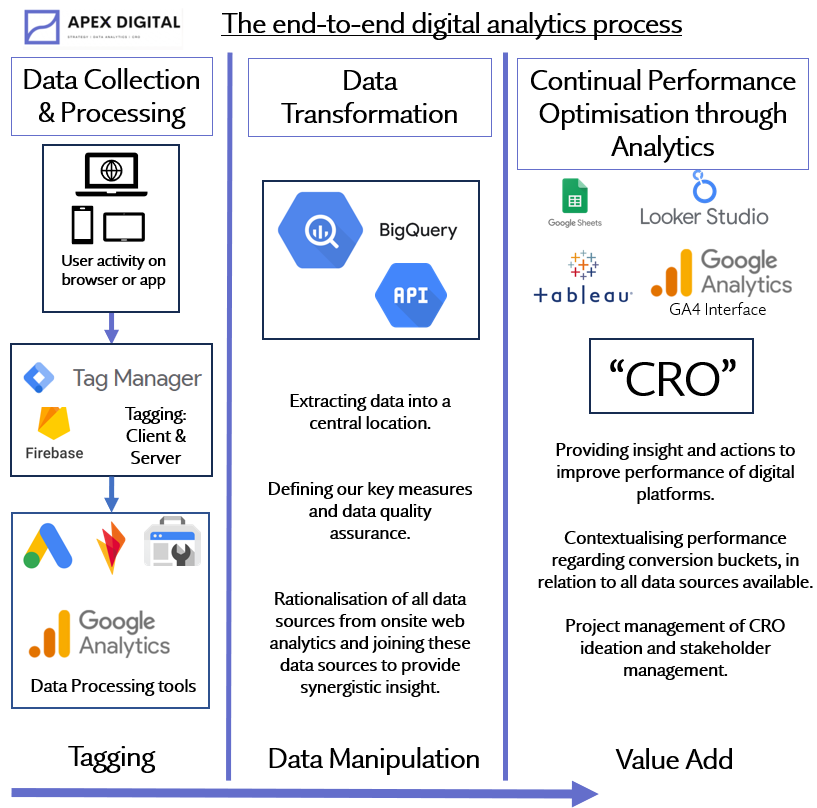Digital analysts need to go beyond one set of skills.
Often in digital analytics recruitment, the focus is on someone to own a deliverable or tool, but this does not consider the broader role requirements needed for effective project delivery. This generally leads to digital analysts getting really good at one bucket of analytics, such as implementation, event setup, or the usage of Google Analytics 4 (GA4) to provide insight on the performance of the digital product. But often the skills are spread within teams, and short-term team priorities can distract the process of providing effective performance insights, focussed on the long term, this is where Digital Analytics freelancers come in.
Analytics roles are frequently scoped in an out-of-date way, and don’t consider the new complex realities of modern digital analytics. It is so much more complex than simply running Google Analytics in the background of a website, and dipping into it when is required. Now, the process needs strategic planning and enhanced technical skills.
Digital Analysts need to be able to:
- Implement tagging for analytics & marketing data collection
- Ideally know JavaScript and how to write functions
- Know who to implement server-side tracking / tagging
- Have an understanding of marketing strategy, its challenges and be creatively minded
- Know how campaigns and attribution modelling impact the data
- Be a good data analyst, be highly data literate
- Be able to write SQL to prepare data tables and gain advanced insights
- Have good stakeholder management skills and ability to run projects

Finding a full-time hire with capabilities across these buckets is challenging. The value add is always greater when there has been thorough oversight across all elements of the process. This is the main benefits of Digital Analytics freelancers
Bucket 1 – Data Collection and Processing
Garbage in = Garbage out
Setting up data collection on a digital platform, known as tagging, involves establishing a data architecture. This includes configuring GA4 through Google Tag Manager (GTM) and customising event tracking to suit specific platform needs. Without careful tag planning and data strategy, tagging can easily fail. It’s more intricate than merely placing a few tags on a website for tracking, especially in GA4, where data collection now has fewer restrictions, but also less built in by default, potentially leading to overwhelming quantities of data without professional setup.
Proficiency in JavaScript is crucial in this phase, facilitating easier and more robust data collection through hard-coded event triggering. It allows for transforming variables to enable detailed, streamlined, and high-quality data gathering. While Google Tag Manager acts as an interface for JavaScript code central to website data collection, incorporating additional JavaScript functions within GTM is preferred for advanced capabilities, such as leveraging 1st party data, surpassing standard GA4 capabilities.
Getting the data collection phase right is essential for success in the subsequent two phases. The phrase “garbage in, garbage out” could not be more true in the digital analytics context. Better data in the top, means better insights on the other end.
Bucket 2 – Data manipulation and transformation
BigQuery allows better use of the collected data in every way
In my article, Google BigQuery should be integral to your digital analytics tech stack, I discuss this in more detail. I argue that integrating Google BigQuery into your analytics infrastructure addresses the limitations of using standalone GA4 reporting, for example, Google’s recent changes that introduced sampling for many more GA4 standard properties, affecting data accuracy. BigQuery resolves this, enabling unsampled analysis, offering indefinite data storage, immediate access, accurate user segmentation, and more robust, well defined conversion measurement. BigQuery allows better use of the collected data in every way.
The knowledge of SQL is essential to bypass these limitations in GA4, but it’s also very useful to tie this stage into both collection and reporting strategies to maximise the efficiency of the entire process.
Bucket 3 – Analytics and Conversion Rate Optimisation
Understanding the data strategy & processes is crucial for analytical success
Now we have got to the stage that is the most useful bit, the actions derived from the data, in my other article covering Conversion Rate Optimisation (CRO), I argue that understanding the data strategy & processes is crucial for analytical success. In summary, there should be a holistic, long – term approach to conversion optimisation, integrating all the data from both onsite and offsite. You can’t have effective benchmarking, or recommend conversion enhancement strategies if the data you are using is subject to change, is heavily sampled, or is not defined accurately.
Ultimately, the person doing onsite analytics of customer journeys must be able to contextualise this within the typical user behaviour for a product, and understand the marketing processes behind acquiring and retaining these customers and then relating user behaviour back to this. Therefore, Digital analytics is a perfect mix of data analytics, data strategy and marketing skills.
Why it is important to tie these buckets together
Gain a deep understanding of how to leverage the data and enhance performance
The principle is simple. By having one person having oversight on the entire process, they get a deep understanding of how to leverage the data and enhance performance. Obviously the best practice in any organisation is to keep very accurate documentation on how properties are set up and how to access each data point. Even with documentation, it takes more time to understand how something has been setup by someone else. The problem with documentation is that its retroactive, you are being given information, and then you need to work out how to integrate it together, whereas, if the same person is involved, they can take this into account in the data collection phase.
For example, CRO is done far more effectively when the capability of the data is known to analysts and can be enhanced to incorporate new measures without needing to consult other teams to do this for them, increasing agility to which insights can be provided.
Similarly, SQL queries are much more efficient when the analyst knows how the data has been collected, and queries can be simplified by tagging the digital platforms in a consistent fashion. For example, in businesses with many verticals we can combine a Google Analytics account to collect the data for all verticals and split it by using common dimensions. Therefore, much simpler code can be written where these data are grouped by these dimensions, without having to repeat different tables and shoehorn them together when they weren’t designed that way from the outset.
Why choose freelancers or agencies over full-time analysts in the digital analytics context?
The key issue with finding one full-time person with the skills to cover the above digital analytics process is very difficult, and can get very expensive when considering recruiter fees, high salaries, and time taken devoted to a full-time hiring process.
If you are keen to get in a full time hire quickly, you may need to settle for 1 or 2 of these buckets, then invest time in training and development. The combination of the hiring process and this training period takes valuable time away from already time-poor teams.
Other reasons:
Freelancers cost less in the long term:
Analysts with all these skills are very expensive and are a full-time commitment. Yes, freelancers do charge typically more per day than your average employee, but you aren’t committed to freelancers in the same way and consider savings in pensions, employee benefits and taxes. If you manage a growing team, own a start-up, or manage a team or a process within an established business, hiring freelancers can be the best way to get skills on-demand without the commitment of hiring a full-time employee.
Freelancers are on-demand with low risk:
Don’t wait for 2 or 3 months to get a hire into your business when you can hire a freelancer to start your project right away.
Freelancers have unique skills and experience from across industries:
You can utilise a freelancer’s talent whenever you see fit. have experience from a wide range of clients and can use best practices gained from other industries and digital implementations they manage.
Digital Analytics Freelancers provide non-biased opinion on performance:
Freelancers aren’t affected by legacy culture or processes. if there is a process to improve, a freelancer will recommend for it to be improved. They are not to be burdened with “the way it has always been done”, or fear of disagreement from senior executives. Freelancers provide independent, unbiased appraisal of current issues and how to best solve them.
Freelancers work on well-defined projects:
the above, freelancers work within well scoped and clearly defined parameters. The deliverables are clear and the freelancer is accountable for ensuring they are delivered on time and on budget. This leads to higher productivity and higher quality output than a full-time hire.
Why choose me as a Digital Analytics freelancer to work for your business?
With Apex Digital, I can provide the entirety of the above process or any element of it, on demand. This saves you time and money in the long term and benefits your business by having projects completed quickly.

Contact me today
Read on:
-
10 things to analyse that will improve website performance
What are the most effective data points to track that tell you how well your website is functioning? The purpose of most websites is either to drive ecommerce sales, drive leads or drive engagement with content. Some of these are applicable to all of these, while some are quite specific. The key metric we should…
-
Privacy Sandbox: What is happening to 3rd party cookies?
You may have seen some noise online about the phasing out of third-party cookies and the introduction of Google’s Privacy Sandbox. This post is to explain what this means in varying aspects of digital marketing. There’s lots of emotive & negative language to describe this change. Some may call it a “cookie-pocalypse”, be very wary…
-
Alternatives to GA4 (Part 1): Where is Digital Analytics Heading?
What other Digital Analytics tools are available? There are many Digital Analytics Tools that are alternatives to Google Analytics 4 (GA4) on the market today. These existed before GA4, but have come to the forefront because of the consensus that standard GA4 can be limited for many basic use cases. In this article I’m going…
